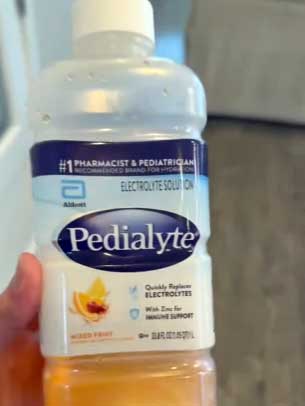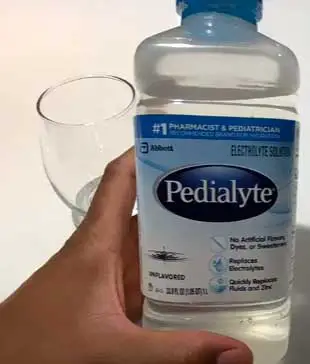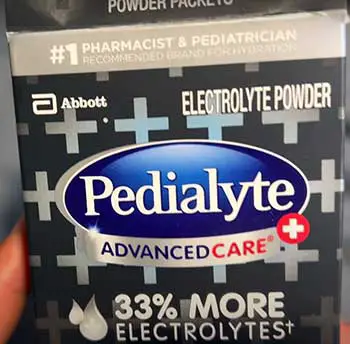I’ve stood in that aisle, just like you. On one side, the neon rainbow of Gatorade, a symbol of athletic triumph. On the other, the medicinal, almost serious-looking bottles of Pedialyte, tucked near the baby food. It feels like a choice between two entirely different worlds.
But when you’re dehydrated—whether from a brutal workout or a miserable stomach flu—which one is the right call? As someone who has used both for very different reasons, I’ve learned they are not interchangeable.
My goal here is to show you the why behind each bottle, so you know exactly which one to reach for.
The Quick-Glance Showdown
| The Core Feature | Gatorade (The Athlete’s Fuel) | Pedialyte (The Recovery Agent) |
| Primary Mission | Fueling performance. Designed to replace carbs (sugar) and some electrolytes lost during intense exercise. | Medical rehydration. Designed to rapidly replace fluids and electrolytes lost from vomiting, diarrhea, or extreme heat. |
| The Sugar Situation | High. Around 21 grams per 12 oz. This is its feature, not its flaw. It’s fast-acting energy. | Low. Around 9 grams per 12 oz. It’s just enough sugar to help the body absorb the electrolytes. |
| The Salt Factor (Sodium) | Moderate. Around 160 mg per 12 oz. Replaces what you sweat out. | Very High. Around 370 mg per 12 oz. This is the key. It’s built to aggressively correct electrolyte imbalances. |
| Potassium Power | Low. Around 45 mg per 12 oz. | High. Around 280 mg per 12 oz. A critical electrolyte for cell and muscle function. |
| The “Secret” Weapon | Carbohydrates. The sucrose-dextrose blend is pure, quick energy for working muscles. | Zinc. Many formulas include zinc, which is medically shown to help reduce the duration of diarrhea. |
| Common Vibe | Tastes sweet, fruity, and refreshing. Designed for “palatability” so you’ll keep drinking it during a game. | Can taste noticeably salty or “medicinal” to some. New flavors are much better, but the salt is present. |
| Aisle Location | Soda aisle, sports section, gas station checkout. | Pharmacy, baby care aisle, or behind the counter. |
Gatorade: The Sideline Superstar Examined
When I think of Gatorade, I think of the “Gatorade bath,” sticky orange coolers, and Michael Jordan. It was born on a football field at the University of Florida in the 1960s to help the Gators stop wilting in the heat. Its formula was revolutionary for athletes.
It wasn’t just water; it was water plus sugar (for energy) and electrolytes (for sweat loss). This is the lens through which we have to see this drink. It’s a performance tool.
The Pros of Gatorade
- Fuel for the Fire: The Carbohydrate Advantage

This is, without a doubt, Gatorade’s biggest “pro” in the right context.
When I’m on a long-distance run or deep into the third set of a tennis match, my body’s readily available energy stores—glycogen—are running on empty.
Water can’t fix that.
The 21 grams of sugar (a mix of sucrose and dextrose) in a 12-ounce serving aren’t just for taste; they are a rapid-delivery fuel source.
This sugar is absorbed into the bloodstream, giving my muscles the quick-hit energy they need to keep contracting and performing.
For an endurance athlete, this isn’t a “con”; it’s the entire point. Pedialyte, with its mere 9 grams of sugar, simply cannot serve this purpose. It’s the difference between refueling the tank and just topping off the radiator fluid.
- Taste and Palatability: Why It’s Easy to Drink
Let’s be honest. When you’re exhausted, hot, and gasping for air, the last thing you want is something that tastes bad. Gatorade’s chemists are masters of “palatability”—a scientific term for “this tastes good so you’ll drink more of it.”
The bright, sweet, and slightly tangy flavors of Cool Blue, Lemon-Lime, or Fruit Punch encourage you to keep drinking. This is a critical physiological trick. It helps athletes and laborers stay hydrated before they even feel thirsty, warding off the dangerous-performance-killing effects of dehydration.
I know I’m far more likely to finish a 32-ounce bottle of cold Gatorade during a hike than I am a bottle of plain water, which helps me stay ahead of fluid loss.
- Accessibility and Variety: A Flavor for Everyone, Everywhere
I can find a Gatorade in literally any gas station, vending machine, or corner store in the country. This convenience is a massive advantage. Dehydration doesn’t always happen when you’re prepared. This accessibility means a reliable hydration and fuel source is always within arm’s reach.
Furthermore, the sheer variety is staggering. Gatorade Thirst Quencher, G Zero (no sugar), G2 (low sugar), Gatorlyte (higher electrolytes, more on this later). This allows me to tailor my choice. If I’m just doing light yard work, I might grab a G Zero.
If I’m about to play 18 holes of golf in 95-degree heat, I’m grabbing the classic Thirst Quencher.
- The Right Tool for the Athletic Job
Ultimately, Gatorade’s pro is its precise design. It was formulated to solve a specific problem: fluid and energy loss during exercise. It provides a 6-8% carbohydrate solution, which is considered an optimal concentration for rapid absorption and energy delivery at the same time.
It’s not meant to be a daily soft drink, and it’s not meant to cure a stomach virus. It is a piece of athletic equipment, just like running shoes or a helmet. When I use it for its intended purpose, it works perfectly.
The Cons of Gatorade
- The Sugar Overload: When It’s Too Much

Here is the other side of that “fuel” coin.
The biggest pro becomes the biggest con the second you’re not exercising.
That high sugar content is a disaster for a sedentary person.
When I see people drinking a 32-ounce Gatorade at their office desk, I’m looking at someone consuming over 56 grams of sugar—more than a can of Coke.
This is a massive, unnecessary caloric load. It spikes insulin, contributes to weight gain, and, over time, increases the risk of type 2 diabetes.
The marketing has been so successful that we’ve mentally recategorized Gatorade as a “health drink,” when for the average person just sitting around, it’s really just a sugary beverage.
- Not the Sickness Solution: The Electrolyte Mismatch
This is the most critical mistake I see people make. When I’ve had a stomach flu, the last thing my body needs is a massive sugar bomb. Severe dehydration from diarrhea and vomiting isn’t just about water loss; it’s a critical loss of sodium and potassium.
Gatorade’s formula is not designed to fix this. It has some sodium, but not nearly enough to correct a medical-grade imbalance. In fact, that high concentration of sugar can make diarrhea worse for some people.2 The sugar can draw water into the intestines (a process called osmotic effect), which is the exact opposite of what you need.3
- Artificial Ingredients: Dyes and Flavors
I’ve become more conscious of what’s in my food, and Gatorade’s ingredient list can be… unappealing. To get those vibrant “Cool Blue” and “Riptide Rush” colors, they use artificial dyes like Blue 1 and Red 40.
While approved by the FDA, many consumers are actively trying to avoid these. For me, it’s less of a health concern and more of a preference. I don’t strictly need my rehydration drink to be neon blue. These dyes and artificial flavors are purely for marketing and palatability, not for performance or health.
- The “Casual” Sipping Problem: Unnecessary Calories
Related to the sugar overload, this is the behavioral con. Because it’s marketed as a “thirst quencher,” it’s easy to grab one instead of water on a hot day. But water has zero calories. Gatorade has over 200 in a 32-ounce bottle.
I have to constantly remind myself that “thirst” does not automatically equal “need for 56 grams of carbs.” For casual dehydration (a hot day, a long car ride), water is almost always the superior choice. Gatorade is for sweat, exertion, and calories burned.
Pedialyte: The Medical Cabinet Mainstay Uncovered
My first real experience with Pedialyte wasn’t for myself, but for a family member who was incredibly sick. The doctor didn’t say “go get a sports drink”; they said “go get Pedialyte.” This drink was born in the world of pediatrics and medicine.
It’s an “Oral Rehydration Solution” (ORS). Its entire chemical makeup is based on World Health Organization guidelines for treating dehydration from illnesses like cholera and rotavirus. It has one job: get fluids and electrolytes back into a compromised body as fast as humanly possible.
Also Read: Comparison of HydroMATE And Liquid I.V.
The Pros of Pedialyte
- The Rehydration Gold Standard: The Electrolyte Profile

This is Pedialyte’s superpower.
Let’s look at the numbers again. A 12-ounce serving has around 370 mg of sodium and 280 mg of potassium.
Compare that to Gatorade’s 160 mg and 45 mg, respectively.
It’s not even a close fight. When you are sick (vomiting or diarrhea), your body is dumping these critical electrolytes.
This imbalance is what makes you feel so weak, dizzy, and terrible.
Pedialyte is formulated to replenish these aggressively.
The lower sugar content is also key. It uses a precise, small amount of sugar (dextrose) because glucose is a co-transporter; it literally helps pull the sodium and water from the intestine into the bloodstream. It’s not there for fuel; it’s there to act as the “key” that unlocks the absorption.
- Medically Formulated: Designed for Sickness
Because it was designed for infants and children with diarrhea, its formulation is precise and safe for a compromised gastrointestinal (GI) system. As I mentioned, Gatorade’s high sugar load can irritate an already-upset stomach and worsen diarrhea.
Pedialyte’s “osmolarity”—the concentration of particles in the solution—is optimized to be gentle and promote absorption, not expulsion. This is why it’s the number-one recommendation from pediatricians and doctors for illness-related dehydration.
- The Zinc Bonus: Aiding Gut Recovery
This is a feature I didn’t even know about for years. Many Pedialyte formulas (like the Classic version) contain zinc.
This isn’t just a random vitamin. Medical studies have shown that zinc supplementation can help reduce the severity and duration of diarrhea, particularly in children.
It’s thought to help repair the gut lining and support the immune system. Gatorade does not have this. This is a clear indicator of Pedialyte’s medical-first design. It’s not just replacing what’s lost; it’s actively helping you recover from the underlying issue.
- Lower Sugar, Higher Purpose
For anyone who isn’t running a marathon, Pedialyte’s lower sugar content is a massive pro. It rehydrates you effectively without the massive calorie load or the dramatic insulin spike. This makes it a much better choice for general, non-exercise-related dehydration. It’s also the go-to for a different, famous use: the hangover.
A hangover is a combination of dehydration, electrolyte imbalance, and the toxic effects of alcohol. Pedialyte directly addresses the first two points far more effectively than a sports drink, without adding a bunch of sugar you don’t need.9
The Cons of Pedialyte
- The Taste Hurdle: That Salty Kick

I’ll be blunt: many people do not like the taste of Pedialyte.
The new flavors are a huge improvement, but you cannot hide 370 mg of sodium.
It has a distinct, slightly salty, “brothy” undertone that is absent from sweet sports drinks.
When I’m feeling sick, this can sometimes be a little hard to get down, even though I know it’s what’s best for me.
This is the opposite of Gatorade’s palatability.
Its taste is a reflection of its medical function, not a feature for casual enjoyment.
- The Price Tag: Paying for Precision
Go to the store and compare the price per ounce. Pedialyte is significantly more expensive than Gatorade. You’re not paying for marketing or celebrity endorsements; you’re paying for a specialized, medical-grade formulation.
A big liter bottle of Pedialyte can cost as much as a case of Gatorade. This cost can be a barrier. When I’ve needed it for a sick family member, I pay it without a second thought. But for general hydration? It’s a costly option.
- Not a Sports Drink: The Missing Fuel
This is the con that athletes need to understand. If I tried to fuel a half-marathon with Pedialyte, I would “bonk” or “hit the wall.” My body would be hydrated and full of electrolytes, but my muscles would have no fuel to burn.
It simply does not contain the necessary carbohydrates to support sustained athletic performance. It’s the wrong tool for that job. An athlete drinking it during an event would be handicapping their own energy supply.
- Overkill for Casual Hydration
Just as Gatorade is sugar-overkill for a desk job, Pedialyte is electrolyte-overkill for a walk in the park. If I’m just a little thirsty after running errands, drinking a Pedialyte is unnecessary. My body isn’t in a state of medical-grade electrolyte depletion.
Plain water is 100% sufficient. Using Pedialyte casually not only costs more but also gives your body a jolt of sodium it likely doesn’t need.
Also Read: Comparison of SodaStream Terra And E-Terra.
Head-to-Head Comparison of Gatorade And Pedialyte
So, we’ve established the facts. Gatorade is fuel.10 Pedialyte is medicine.11 Let’s apply this to the real-life situations where I’ve had to make the choice.
- The Scenario: You have the stomach flu.
The Winner: Pedialyte. No contest.
This is Pedialyte’s home turf. You are losing fluids, sodium, and potassium at an alarming rate. Your gut is compromised. You need medical-grade rehydration, not sugar fuel. Gatorade’s high sugar content could make your symptoms worse.
Pedialyte’s precise balance of electrolytes (plus zinc) is designed for this exact moment.12 Sip it slowly.
- The Scenario: You are running a marathon.
The Winner: Gatorade (or a similar sports drink).
This is Gatorade’s home turf. After 60-90 minutes of high-intensity exercise, your glycogen stores are depleted. You need to replace fluids, some sodium, and carbohydrates (fuel).
Pedialyte will fail you here. It won’t provide the energy your muscles are screaming for. This is what Gatorade was invented for.
- The Scenario: You have a brutal hangover.
The Winner: Pedialyte.

This one is more nuanced, but I lean heavily toward Pedialyte.
A hangover is primarily about severe dehydration and the inflammatory effects of alcohol.
Your body is craving fluid and electrolytes, not a 10K run’s worth of sugar.
Pedialyte rebalances your system more efficiently with its high-sodium, high-potassium formula.
The sugar in Gatorade isn’t really the primary thing your body needs in this moment of recovery.
- The Scenario: You spent all day mowing the lawn in 100°F heat.
The Winner: It’s a tie, but with conditions.
This is the gray area. You’ve been sweating heavily for a long time, so you’ve lost both fluids and electrolytes. You’ve also burned a lot of calories.
- Go for Gatorade if: You were working hard and continuously for 2+ hours and feel physically spent and energy-depleted. You need the carbs.
- Go for Pedialyte if: The main symptom is just overwhelming dehydration—dizziness, headache, extreme thirst—and you weren’t necessarily doing high-intensity athletic work. It will rebalance you faster.
- The real answer? Honestly, a G Zero or Gatorlyte (Gatorade’s high-electrolyte version) might be the perfect compromise.
Also Read: Comparison of Liquid I.V. And Pedialyte.
Frequently Asked Questions (FAQ)
Athletes need fuel. Pedialyte lacks the high-carbohydrate (sugar) content that athletes require to replenish energy stores (glycogen) during long or intense exercise. Gatorade provides both hydration and this critical fuel source.
Pedialyte (or a similar oral rehydration solution). Its formula is medically designed with a higher concentration of electrolytes (especially sodium and potassium) and a lower amount of sugar, which is ideal for rehydrating from vomiting or diarrhea.15
The main downsides are its taste (it can be noticeably salty), its high cost compared to sports drinks, and the fact that it’s not a source of fuel for athletic performance.
It is generally considered safe in moderation, and many doctors recommend it for dehydration caused by morning sickness.16 However, you should always consult your doctor before taking any new supplement or medical product during pregnancy.
Conclusion: The Right Tool For The Right Job
After laying it all out, my conclusion is simple: this was never a fair fight. We’re comparing a mechanic’s socket wrench to a surgeon’s scalpel.
Gatorade is a fueling tool. Pedialyte is a medical tool.
The next time you’re in that aisle, the choice should be clear. If you need to perform, grab the Gatorade. If you need to recover, grab the Pedialyte. I’ve learned to stop asking “Which one is better?” and start asking, “What does my body need right now?”
And I hope that after this, you can, too.
